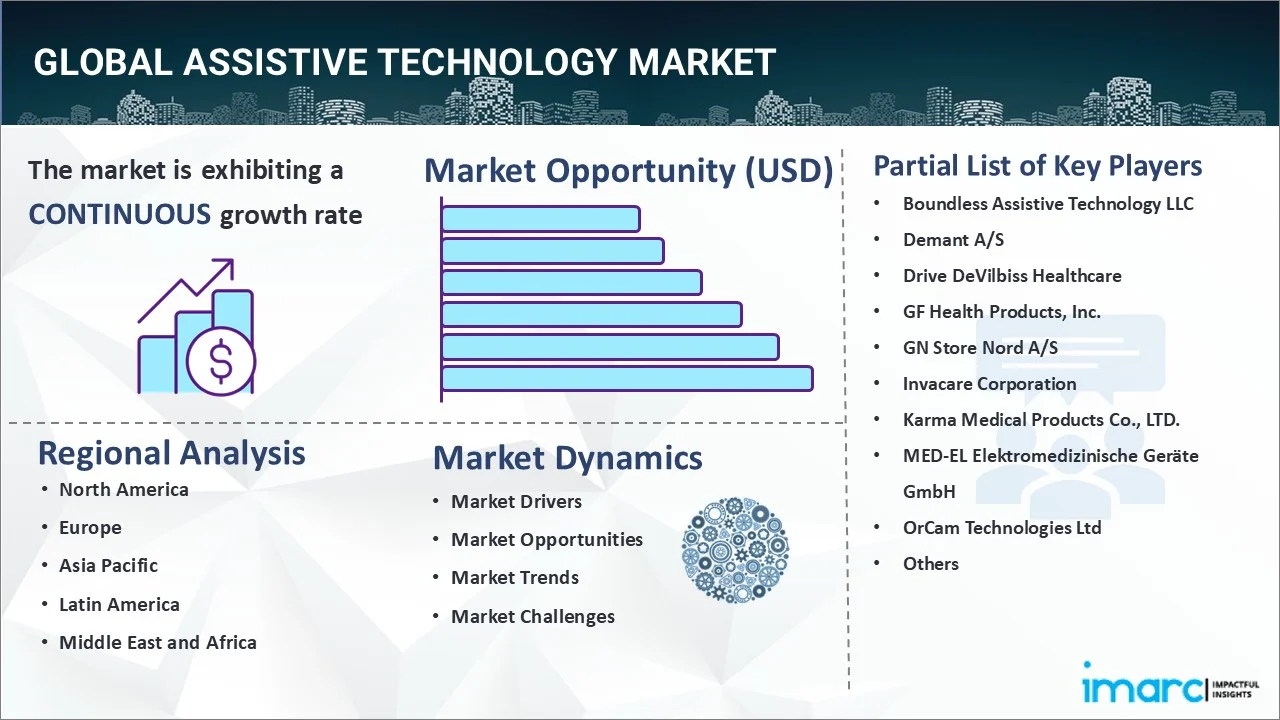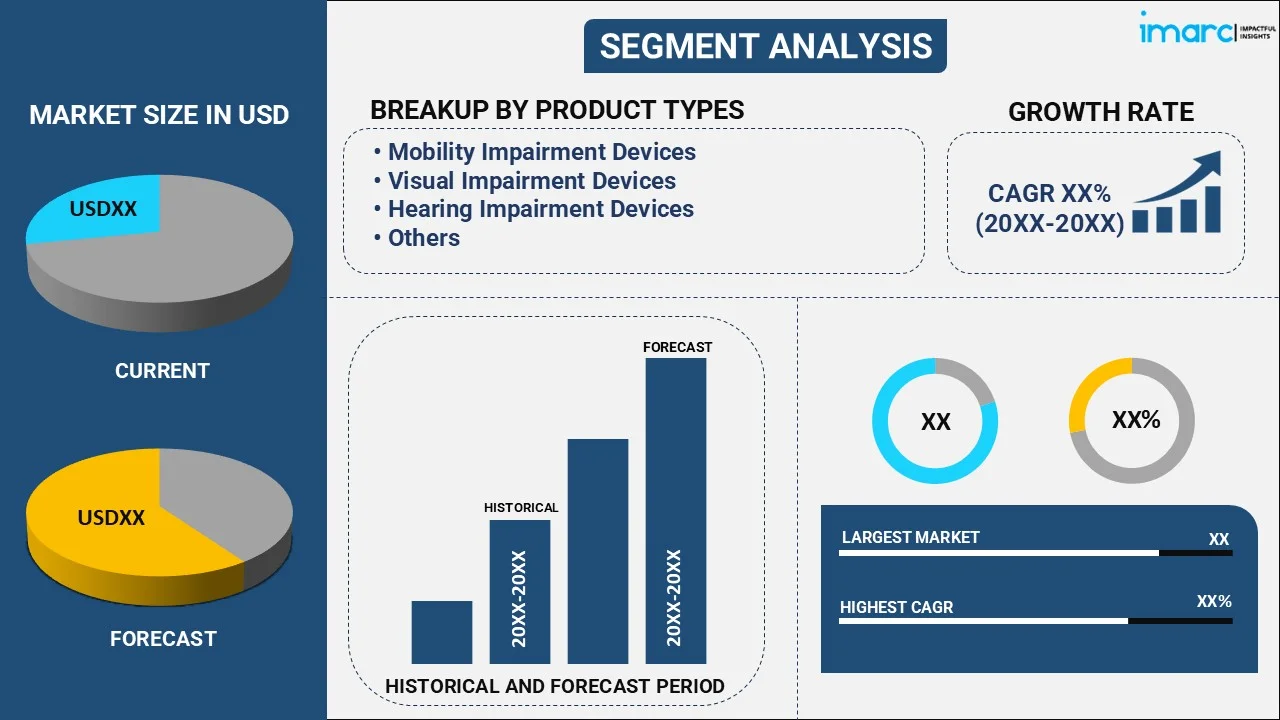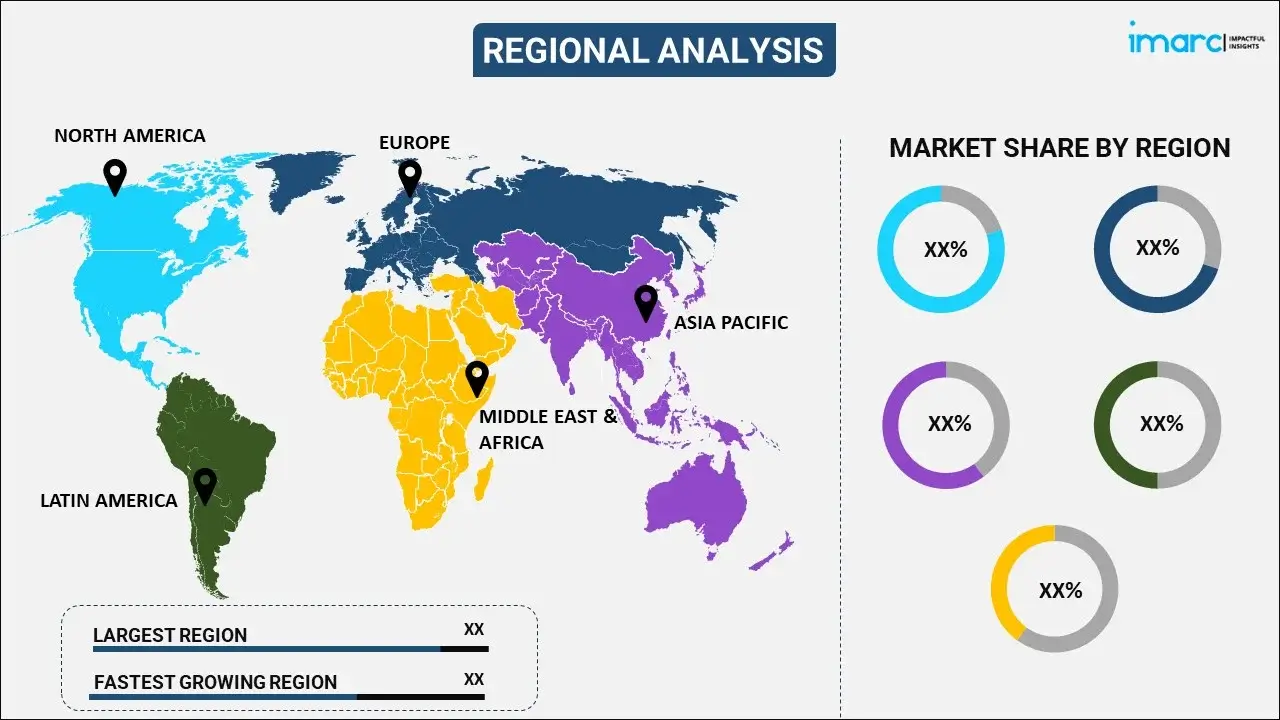
Assistive Technology Market Report by Product Type (Mobility Impairment Devices, Visual Impairment Devices, Hearing Impairment Devices, and Others), End User (Hospitals, Home Care Settings, and Others), and Region 2025-2033
Market Overview:
The global assistive technology market size reached USD 26.8 Billion in 2024. Looking forward, IMARC Group expects the market to reach USD 41.0 Billion by 2033, exhibiting a growth rate (CAGR) of 4.33% during 2025-2033. The growing geriatric population, favorable government initiatives, and increasing emergence of advanced technologies, such as the Internet of Things (IoT), artificial intelligence (AI) and machine learning (ML), are some of the major factors propelling the market.
|
Report Attribute
|
Key Statistics
|
|---|---|
|
Base Year
|
2024 |
|
Forecast Years
|
2025-2033
|
|
Historical Years
|
2019-2024
|
| Market Size in 2024 | USD 26.8 Billion |
| Market Forecast in 2033 | USD 41.0 Billion |
| Market Growth Rate (2025-2033) | 4.33% |
Assistive technology comprises a diverse range of devices, equipment, software, and systems that are designed to enhance the functional capabilities and independence of individuals with disabilities. It involves various categories, such as mobility aids, communication devices, hearing and vision aids, cognitive support tools, and adaptive software. It assists individuals in performing numerous tasks that are challenging to complete. It aids in mitigating barriers and empowering individuals to actively participate in educational, vocational, and daily life activities. It benefits in promoting inclusion, accessibility, and equality for people with diverse abilities.

At present, the rising awareness and recognition among individuals, caregivers, and healthcare professionals around the world is supporting the growth of the market. Besides this, the increasing incidence of disabilities, such as hearing impairment, visual impairment, and mobility challenges, is strengthening the growth of the market. In line with this, the growing demand for assistive technology due to its cost-effectiveness and positive outcomes is positively influencing the market. Apart from this, increasing advancements in healthcare infrastructure and facilities across the globe are offering lucrative growth opportunities to industry investors. In addition, the rising focus on inclusive designs is bolstering the growth of the market. Additionally, the wide and easy availability of assistive technology products through online and offline distribution channels is impelling the growth of the market.
Assistive Technology Market Trends/Drivers:
Rising geriatric population
There is a rise in the adoption of assistive devices among the geriatric population, as they are more prone to various health conditions. These devices address the problems by offering products, such as mobility aids, hearing aids, voice-activated assistants, and smart home automation. Besides this, there is an associated increase in age-related disabilities and chronic health conditions among people in old age. In line with this, old age individuals may face challenges in mobility, vision, hearing, and cognition. As a result, the rising preference for solutions that allow them to maintain their independence and engage actively in daily activities and enhance their overall quality of life is contributing to the growth of the market.
Favorable government initiatives
Governing agencies of several countries are recognizing the importance of promoting inclusivity and accessibility for individuals with disabilities. In addition, they are implementing policies and initiatives to encourage the adoption of assistive technology among the masses. In the healthcare sector, governing authorities are focusing on providing subsidies on the purchase of assistive devices, which is offering a positive market outlook. Besides this, educational institutions are incorporating these technologies into classrooms to ensure equal access to education for students with disabilities. In line with this, workplace accommodations and incentives are often provided to employers to support the integration of assistive technology for employees with disabilities.
Increasing emergence of advanced technologies
The rising development of innovative solutions that cater to diverse disabilities and challenges. In addition, the rising emergence of artificial intelligence (AI) and machine learning (ML) algorithms to enable the creation of advanced prosthetics with intuitive movement and customization is positively influencing the market. Apart from this, the integration of the Internet of Things (IoT) in interconnected systems allows seamless communication and data sharing. Moreover, wearable devices are becoming more popular among individuals and provide real-time health monitoring and emergency assistance. The integration of these technologies in consumer products, such as smartphones and tablets, assists in attracting a wide consumer base as they are making devices more user-friendly and adaptable to individual needs.
Assistive Technology Industry Segmentation:
IMARC Group provides an analysis of the key trends in each segment of the global assistive technology market report, along with forecasts at the global, regional, and country levels from 2025-2033. Our report has categorized the market based on product type and end user.
Breakup by Product Type:

- Mobility Impairment Devices
- Visual Impairment Devices
- Hearing Impairment Devices
- Others
The report has provided a detailed breakup and analysis of the market based on the product type. This includes mobility impairment devices, visual impairment devices, hearing impairment devices, and others.
Mobility impairment devices include a wide range of assistive devices that are designed to aid individuals with mobility challenges. They comprise wheelchairs, mobility scooters, canes, crutches, walkers, and stair lifts. In line with this, these devices assist people with physical disabilities or limited mobility in moving around independently and safely.
Visual impairment devices comprise solutions that cater to individuals with visual impairments or blindness. These devices include screen readers, magnifiers, Braille displays, optical character recognition (OCR) systems, white canes, and navigation tools. Apart from this, these devices facilitate access to information, digital content, and navigation that allows people with visual impairments to participate actively in various activities.
Hearing impairment devices involve assistive devices that address the needs of individuals with hearing impairments or deafness. They comprise hearing aids, cochlear implants, assistive listening devices, and captioning systems. These technologies enhance auditory perception, communication, and engagement with the environment, that enable individuals with hearing impairments to overcome communication barriers and interact effectively.
Breakup by End User:
- Hospitals
- Home Care Settings
- Others
Hospitals account for the majority of the market share
The report has provided a detailed breakup and analysis of the market based on the end user. This includes hospitals, home care settings, and others. According to the report, hospitals represented the largest segment. The hospital segment includes healthcare facilities, such as general hospitals, specialty hospitals, and rehabilitation centers. These institutions provide comprehensive care and support to patients with disabilities or those recovering from injuries. Hospitals utilize a wide range of assistive devices to enhance patient outcomes and facilitate the recovery process.
Home care settings comprise caregivers, family members, or home healthcare professionals who use assistive devices to assist and support individuals with disabilities in their daily activities in the comfort of their homes. Apart from this, home care settings enable aging individuals or people with disabilities to maintain independence and lead more fulfilling lives within familiar surroundings.
Others include nursing homes, community centers, non-profit organizations, and government agencies that utilize assistive technology to enhance the well-being and independence of individuals with disabilities.
Breakup by Region:

- North America
- United States
- Canada
- Europe
- Germany
- France
- United Kingdom
- Italy
- Spain
- Others
- Asia Pacific
- China
- Japan
- India
- South Korea
- Australia
- Indonesia
- Others
- Latin America
- Brazil
- Mexico
- Others
- Middle East and Africa
North America exhibits a clear dominance, accounting for the largest assistive technology market share
The report has also provided a comprehensive analysis of all the major regional markets, which include North America (the United States and Canada); Europe (Germany, France, the United Kingdom, Italy, Spain, and others); Asia Pacific (China, Japan, India, South Korea, Australia, Indonesia, and others); Latin America (Brazil, Mexico, and others); and the Middle East and Africa.
North America held the biggest market share due to the presence of advanced medical facilities and infrastructure. In line with this, the rising focus on inclusivity and accessibility is bolstering the growth of the market in the region. Apart from this, favorable reimbursement policies to access assistive technologies more easily is contributing to the growth of the market. In addition, the rising awareness about assistive devices among individuals is supporting the growth of the market in the North America region.
Competitive Landscape:
Major players in this industry are investing in research and development (R&D) activities to create enhanced products and solutions. In line with this, they are continuously exploring new technologies, materials, and design concepts to enhance the functionality, usability, and accessibility of their devices. Apart from this, companies are focusing on developing new and improved devices across different categories, such as mobility impairment devices, visual impairment devices, and hearing impairment devices. They aim to address specific user needs and provide tailored solutions to diverse disabilities. In addition, many companies are offering customization and personalization options for their assistive devices, which allows users to have devices that suit their unique needs and preferences.
The report has provided a comprehensive analysis of the competitive landscape in the market. Detailed profiles of all major companies have also been provided. Some of the key players in the market include:
- Boundless Assistive Technology LLC
- Demant A/S
- Drive DeVilbiss Healthcare
- GF Health Products, Inc.
- GN Store Nord A/S
- Invacare Corporation
- Karma Medical Products Co., LTD.
- MED-EL Elektromedizinische Geräte GmbH
- OrCam Technologies Ltd
- Ostrich Mobility Instruments Pvt. Ltd
- Ottobock SE & Co. KGaA
Assistive Technology Market Report Scope:
| Report Features | Details |
|---|---|
| Base Year of the Analysis | 2024 |
| Historical Period | 2019-2024 |
| Forecast Period | 2025-2033 |
| Units | Billion USD |
| Scope of the Report | Exploration of Historical and Forecast Trends, Industry Catalysts and Challenges, Segment-Wise Historical and Predictive Market Assessment:
|
| Product Types Covered | Mobility Impairment Devices, Visual Impairment Devices, Hearing Impairment Devices, Others |
| End Users Covered | Hospitals, Home Care Settings, Others |
| Regions Covered | Asia Pacific, Europe, North America, Latin America, Middle East and Africa |
| Countries Covered | United States, Canada, Germany, France, United Kingdom, Italy, Spain, China, Japan, India, South Korea, Australia, Indonesia, Brazil, Mexico |
| Companies Covered | Boundless Assistive Technology LLC, Demant A/S, Drive DeVilbiss Healthcare, GF Health Products, Inc., GN Store Nord A/S, Invacare Corporation, Karma Medical Products Co., LTD., MED-EL Elektromedizinische Geräte GmbH, OrCam Technologies Ltd, Ostrich Mobility Instruments Pvt. Ltd, Ottobock SE & Co. KGaA, etc. |
| Customization Scope | 10% Free Customization |
| Post-Sale Analyst Support | 10-12 Weeks |
| Delivery Format | PDF and Excel through Email (We can also provide the editable version of the report in PPT/Word format on special request) |
Key Questions Answered in This Report:
- How has the global assistive technology market performed so far, and how will it perform in the coming years?
- What are the drivers, restraints, and opportunities in the global assistive technology market?
- What is the impact of each driver, restraint, and opportunity on the global assistive technology market?
- What are the key regional markets?
- Which countries represent the most attractive assistive technology market?
- What is the breakup of the market based on the product type?
- Which is the most attractive product type in the assistive technology market?
- What is the breakup of the market based on the end user?
- Which is the most attractive end user in the assistive technology market?
- What is the competitive structure of the global assistive technology market?
- Who are the key players/companies in the global assistive technology market?
Key Benefits for Stakeholders:
- IMARC’s report offers a comprehensive quantitative analysis of various market segments, historical and current market trends, market forecasts, and dynamics of the assistive technology market from 2019-2033.
- The research study provides the latest information on the market drivers, challenges, and opportunities in the global assistive technology market.
- The study maps the leading, as well as the fastest-growing, regional markets. It further enables stakeholders to identify the key country-level markets within each region.
- Porter's five forces analysis assist stakeholders in assessing the impact of new entrants, competitive rivalry, supplier power, buyer power, and the threat of substitution. It helps stakeholders to analyze the level of competition within the assistive technology industry and its attractiveness.
- Competitive landscape allows stakeholders to understand their competitive environment and provides an insight into the current positions of key players in the market.
Need more help?
- Speak to our experienced analysts for insights on the current market scenarios.
- Include additional segments and countries to customize the report as per your requirement.
- Gain an unparalleled competitive advantage in your domain by understanding how to utilize the report and positively impacting your operations and revenue.
- For further assistance, please connect with our analysts.
 Inquire Before Buying
Inquire Before Buying
 Speak to an Analyst
Speak to an Analyst
 Request Brochure
Request Brochure
 Request Customization
Request Customization




.webp)




.webp)












